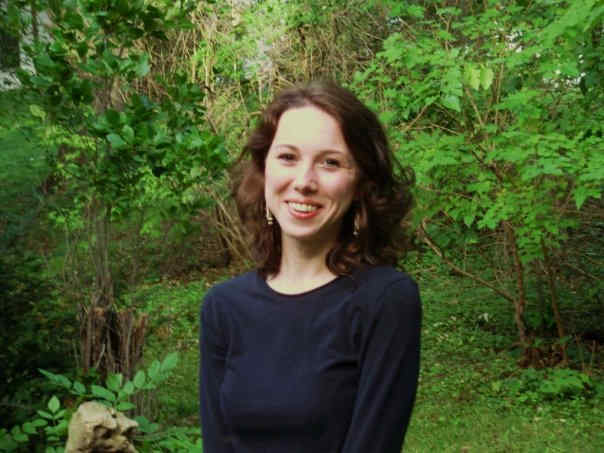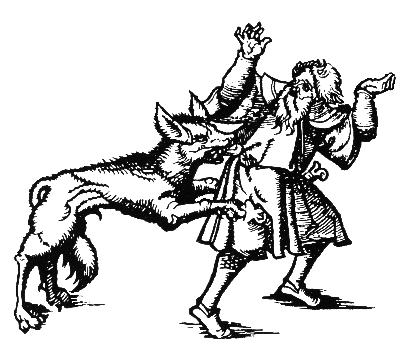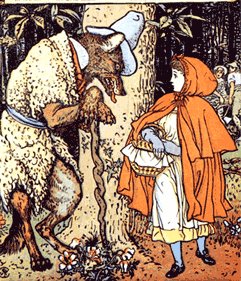A Sleet Interview with Shannon Scott by Wendy A. Skinner
Co-Editor of Terrifying Transformations: An Anthology of Victorian Werewolf Fiction, 1838-1896. Edited by Alexis Easley & Shannon Scott. Valancourt Books. 2012.
Shannon Scott is a St. Paul, Minnesota native and co-editor with Alexis Easley of Terrifying Transformations: An Anthology of Victorian Werewolf Fiction, published by Valancourt Books in 2012. Scott teaches English and Literature classes at University of St. Thomas and St. Catherine University, holds an MA in English and is pursuing her MFA in Creative Writing from Hamline University. Scott is the recipient of honors and awards including the Jo Lynn Terry Memorial Writing Prize and a Split Rock Arts Scholarship. She speaks regularly at conferences about the werewolf as the subject of Victorian and Native American literature. Her work appears in the New Hibernia Review and the Victorian Periodical Review, and she has an essay forthcoming in the anthology, The She-Wolf Collection. When Scott’s not reading Victorian tales, teaching, or howling at the moon, she’s revising her own hair-raising novel-in-progress.
INTRODUCTION
When I began researching wolves for my next writing project, I thought of Shannon Scott. Years ago, she read her work to our MFA class as we crowded around a long narrow table in a fluorescent-lit dank, basement classroom. As I closed my eyes, her reedy soprano voice transformed into the heavily accented alto of a babushka warning about the dangers of black magic and making deals with the devil. Mysterious wolf women and missing village infants soon follow, as well as a Russian mail-order bride wearing a thick fur coat in a confessional as she bartered with a priest for her salvation. Scott clearly knew things about werewolf lore that I did not, so I asked if she would recommend some texts. She recommended reading her Terrifying Transformations: An Anthology of Victorian Werewolf Fiction filled with 359 pages of remote European villages and the wild forests of another era. The stories’ persecuted outcasts, she-devil women, and desperate, mournful wolves enthralled me. At the closing of the last page, “…Lycanthropy, or wolf-madness was not myth, but a dread and appalling reality,” I knew I had to ask Shannon to share more about the Victorian werewolf genre and what it took to publish this seductive, lycanthropic collection.
THE CONVERSATION
SLEET: Terrifying Transformations consists of a 12-page introduction and 359 pages of 15 stories. This is an ambitious project! How did the project begin?
 SHANNON SCOTT: When I was working on my graduate degree in literature at the University of St. Thomas I started focusing on werewolves in every class. My professors were pretty supportive about it and, hopefully, entertained. The lycanthropic monster had put its claws in me and wouldn’t let go! I got teased a little bit about it, called “the werewolf lady,” but everybody has their quirks and monsters. I presented conferences on werewolf stories in Raleigh, Chicago, St. Paul, and London. I've taught a class on werewolf literature. After I wrote my master's essay on Clemence Housman’s “The Were-Wolf,” my advisor, Alexis Easley, thought all these Victorian werewolf stories should be collected in an anthology. I agreed. I had no idea at the time that first, she was serious, and second, how much work it would turn out to be. One of the first things Alexis and I did was write a request for a grant from the Luann Dummer Center for Women. When we got the grant there seemed no way to go but forward.
SHANNON SCOTT: When I was working on my graduate degree in literature at the University of St. Thomas I started focusing on werewolves in every class. My professors were pretty supportive about it and, hopefully, entertained. The lycanthropic monster had put its claws in me and wouldn’t let go! I got teased a little bit about it, called “the werewolf lady,” but everybody has their quirks and monsters. I presented conferences on werewolf stories in Raleigh, Chicago, St. Paul, and London. I've taught a class on werewolf literature. After I wrote my master's essay on Clemence Housman’s “The Were-Wolf,” my advisor, Alexis Easley, thought all these Victorian werewolf stories should be collected in an anthology. I agreed. I had no idea at the time that first, she was serious, and second, how much work it would turn out to be. One of the first things Alexis and I did was write a request for a grant from the Luann Dummer Center for Women. When we got the grant there seemed no way to go but forward.
SLEET: Leave it to an advisor to give you the confidence to dip your toe into the proverbial pool (never mind that it’s 12 feet deep!). Sounds like the anthology was a logical step and after reading it, I can see that you definitely learned how to swim like an Olympian. Contrary to you however, I’ve never studied Victorian Literature before, so I wasn’t quite sure what to expect from Terrifying Transformations. So, dear Werewolf Lady, how do these werewolf tales follow or diverge from other Victorian literature?
SS: That's a good question. I would say that they are a lot more lurid and gory than most Victorian literature, but that's not really true. There were monsters and criminals a plenty both inside and outside the pages of penny dreadfuls. However, as Alexis and I combed through the stories we noticed that the Victorian werewolf, in almost every case, represented an issue or anxiety in Victorian culture.
SLEET: Can you give me an example from the Terrifying Transformations?
SS: Kipling's “The Mark of the Beast.” It deals with colonization in India—a growing area of concern financially and rebellion-wise at the end of the nineteenth century—but it also turns up in each story featuring a female werewolf. Those stories are my favorite. Anytime a female monster has agency, power, and control it's a fascinating read. Unlike the male werewolf, who can be sympathetic and victimized, the female werewolf never is. This may stem from the fears of women's liberation, their growing desire for work and education, the fact that they greatly outnumbered the male population in London at the fin-de-siècle. When we were writing the intro, Alexis and I laughed because I wanted to say the female werewolf was the "furry femme fatale" of Victorian Gothic fiction. I think the "furry" may have been cut. She's much more scholarly in her writing than I am.
SLEET: Yes, I did notice the pattern of the less than admirable, downtrodden male victims and the downright aligned-with-Satan female werewolves! Considering that men wrote 13 of 15 of the stories, I wasn’t surprised. However, that leads me to my question about the one of the two female authors, Catherine Crowe. I had expected so much more from her, but in the end of her “A Story of a Weir Wolf,” She tops off her narrative with this misogynistic conclusion: “…when women shall have learned to hold their tongues, the philosopher’s stone will be discovered, and poverty and wrinkles thereafter cease to deform the earth.” Wow. Sounds like a blame-it-on-Eve Original Sin moralistic expression. Your thoughts?
SS: Yes, it is disappointing. It’s especially so from a female author like Crowe who was so involved in paranormal exploration, lived an unconventional life, and moved in some high literary circles. After her breakdown, when she was found naked in an Edinburgh cemetery, she tried to rebuild her reputation by blaming the incident on a digestive disorder but it didn’t really fly.
I remember reading about Ms. Crowe’s walking naked in Edinburgh and saying that “spirits had made her invisible.” Yikes. That might cause a reputation problem all right.
Charles Dickens, whom I love dearly as writer but could also be a jerk, was particularly snide in his comments about her breakdown. For women at that time, to be prideful and confident on the page could risk such intense scrutiny and humiliation and failure. Victorian society was patriarchal and putting down your own gender may bring a female author closer to male acceptance. Disappointing indeed.
It’s easy to take for granted how much gender roles have changed since 1846 when Crowe published her story—a good two decades before the United States’ Civil War.
There is one other female author, Clemence Housman, whose female werewolf White Fell could be viewed as subversive and even feminist since she was almost as much of a heroine as a villain. She traveled alone, she was handy with an axe, she could outrun a man… What's cool about her 1890 story "The Were-Wolf," was that it first appeared in Atlanta, a journal for girls and young women. I can't help but wonder what they thought of the illustrations of the beautiful woman holding the axe who turns out to be a werewolf. The issue sold out and was later reprinted. I tend to think they loved it and found it liberating to see a powerful (albeit violent) female hero. 
SLEET: All this talk reminds me of how much the author bios and the introduction to the anthology impressed me—at times more than the stories themselves. Was it as much fun for you to write these as it was for me to read them?
SS: No! Not fun at all. Well, maybe a little fun: Alexis and I divvied up the stories so we each researched an equal number of authors and footnoted their stories. My author bios were always too long. I had to whittle Kipling and Doyle way down.
SLEET: Sounds like you were having fun.
SS: The truth is, I loved footnoting and maybe went a little overboard.
SLEET: I got a kick out of many of the footnotes, including “an emotional, melodramatic work of fiction intended to excite the nerves” for “spasmodic novel-writer” and “not lazy about cutting brush or chopping sticks” for “…thou art no laggard at bill-hook and wattle.” (I feel fairly well-versed in Victorian-speak now)
SS: When our editor, Jay [James D. Jenkins], sent us the proofs for the book I must have added another two dozen footnotes that forced him to reformat the whole text. Not very convenient. But it really was information that was needed to understand context. I'm OCD when it comes to footnotes. I remember kibitzing with Alexis over "will-o-wisp."
SLEET: In your opinion, which piece in the anthology exemplifies the classic werewolf story? Why?
SS: I think Wagner is the classic werewolf story (the anthology includes an excerpt) in the way that we've come to know it—Lon Chaney running out into the swamp, hunted by the mob, the sympathetic werewolf. It's also very gory and, if you read the whole novel, shockingly sexual. I guess what I mean is "cinematic"—the werewolf story has become "cinematic" and Wagner is all about visuals and action, with surprisingly little depth of character or philosophy.
SLEET: That ties into my next question. How do you think the resurgence of the fascination with werewolves in commercial publishing today, (for example, the Twilight saga) compare to that of commercial publishing in the Victorian Era?
SS: That's a good question! As far as film goes, the werewolf seems to have found its popular venue in our era, which makes sense due to the visual nature of the monster. However, it's strange to see the werewolf reemerge in commercial publishing in such vivid way. I haven't read the Twilight series, but it sounds like Meyer is attempting to look at transformation from an American Indian, specifically Quileute, perspective, and that could not be more different from the Victorians where transformation was primarily a European-based curse (or at least a mortal curse to others!). But to my knowledge, which is limited, transformation in indigenous American cultures is more about skill and gift than murder or the devil. Very different. 
SLEET: Oh, so insightful! The stories in Terrifying Transformations, although a bit heavy-handed by today’s standards, still held my attention fairly well. What are the top three characteristics of storytelling that you think still hold true 150 years later in these Victorian tales of lycanthropy?
SS: I agree—some of the stories are still quite compelling. Kipling's tale works for me so well because of its characters—the narrator who remains nameless, yet far more than just a witness, Strickland, who is tormented with the ethics of his actions, and Fleete who is completely devoid of ethics. The fact that I couldn't guess what was going to happen next and wanted to know. Good writing. Good characters. (It can make one forgive an imperialist.)
The fairytale quality of George MacDonald's "The Gray Wolf" also appeals to me—the desolate Scottish setting, the feral girl and her mother living in the cave, the young student—a character I actually did not want to see get his throat ripped out.
Finally, I enjoy Housman's "The Were-Wolf" because it can be read so easily as a Christian allegory, but she either purposefully or subconsciously challenges gender on so many levels throughout that story that each time I read it I find something new to puzzle over. When John Lane reprinted the story in 1896 he removed some of the lines that explicitly challenged gender expectations.
SLEET: How did editing this anthology inform your own writing?
SS: I think research can always spark ideas, but the truth is that the time it takes to do a project like this completely robs any time for creative work. I think it's a lie to tell people they can do it all at the same time—between teaching, working on various projects and committees, and trying to cobble together some semblance of a social life, my creative work is usually the first thing to be heaved overboard.
SLEET: Such is the hard truth. Regardless, measured by the success of Terrifying Transformations, your efforts paid off. You and Alexis made a great team! What’s next for you?
SS: I'm working with an amazing group of young women in Manchester, England, who share my predilection for werewolves led by Hannah Priest, a researcher, writer and small press publisher. They’re publishing an essay of mine in their She-Wolf Collection at Manchester University Press. They have a fascinating blog and recently published a volume of short stories: Wolf Girls http://shewolf-manchester.blogspot.com/. Another interesting follower of the female werewolf is artist Jazmina Cininas whose subversive work you can find at: https://www.facebook.com/thegirliewerewolfproject. I guess what I'm saying is I'm not the only "werewolf lady."
# # #
Wendy A. Skinner’s writing howls in The Potomac Journal of Politics and Poetry, MONKEYBICYCLE, Dust & Fire, Muse and elsewhere. One night a month, she transforms into recipient of the 2010 Carol Bly Award in Non-Fiction and the author of Life with Gifted Children: Infinity & Zebra Stripes, winner of the Arizona Glyph Award. She holds an MFA from Hamline University and lives amongst humans on the other 27 nights of the lunar calendar at www.wendyaskinner.com in Minneapolis. This is her second transformative interview for Sleet Magazine.